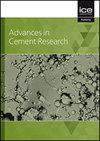Amazon açaí fiber-Portland cement compatibility: a challenge to produce cement-bonded fiberboards?
IF 1.3
4区 工程技术
Q3 CONSTRUCTION & BUILDING TECHNOLOGY
引用次数: 0
Abstract
The açaí waste from Amazon contains short fibers that show potential for reinforcing cement-bonded fiberboards (CBFBs), although their compatibility with cement matrix is still unknown. This work aimed to characterize raw and pretreated açaí fibers and analyze their compatibility with Portland cement by different techniques, besides developing a CBFB. The fibers were subjected to thermal (180, 200, and 220 °C), cold and hot water, alkaline (NaOH), and bleaching (NaOH-H2O2) pretreatments. The chemical and water pretreatments raised the fiber crystalline indexes (28%-57%). The chemical pretreatments individualized the fiber bundles and removed hemicelluloses. Alkali-pretreated and raw fibers had the highest (96%) and lowest (65%) cement compatibility indexes. Portlandite and ettringite appeared after 24 h for most pastes but were delayed for raw and 220 °C-pretreated fibers. In contrast, only the raw fiber specimens reached the required compression strength of 34 MPa after 28 days; hence, they were chosen to produce a CBFB. The boards showed proper thickness swelling (1.4%), but low bending strength (MOE = 647.8 MPa; MOR = 1.9 MPa). Overall, the fiber modifications improved the compatibility with cement, but not the composite's mechanical strength. Açai-fiber CBFB is a promising building material, but future studies must overcome its poor mechanical performance.亚马逊阿萨伊纤维与硅酸盐水泥的兼容性:生产水泥粘结纤维板的挑战?
亚马逊河流域的阿萨伊废弃物中含有短纤维,这些纤维具有增强水泥粘结纤维板(CBFB)的潜力,但它们与水泥基质的兼容性仍是未知数。这项工作的目的是分析未加工和预处理的阿萨伊纤维的特性,并通过不同的技术分析它们与波特兰水泥的兼容性,同时开发一种 CBFB。对纤维进行了热处理(180、200 和 220 °C)、冷水和热水处理、碱处理(NaOH)和漂白处理(NaOH-H2O2)。化学预处理和水预处理提高了纤维的结晶指数(28%-57%)。化学预处理使纤维束个体化,并去除半纤维素。碱预处理纤维和未加工纤维的水泥相容性指数最高(96%),最低(65%)。大多数浆料在 24 小时后出现波长石和乙炔石,但未加工纤维和经 220 °C 预处理的纤维则延迟出现。相比之下,只有原纤维试样在 28 天后达到了所需的 34 兆帕压缩强度;因此,它们被选为生产 CBFB 的试样。这些木板显示出适当的厚度膨胀(1.4%),但弯曲强度较低(MOE = 647.8 兆帕;MOR = 1.9 兆帕)。总的来说,纤维改性提高了与水泥的相容性,但没有提高复合材料的机械强度。阿萨伊纤维 CBFB 是一种很有前途的建筑材料,但未来的研究必须克服其机械性能差的问题。
本文章由计算机程序翻译,如有差异,请以英文原文为准。
求助全文
约1分钟内获得全文
求助全文
来源期刊

Advances in Cement Research
工程技术-材料科学:综合
CiteScore
3.70
自引率
5.00%
发文量
56
审稿时长
3.2 months
期刊介绍:
Advances in Cement Research highlights the scientific ideas and innovations within the cutting-edge cement manufacture industry. It is a global journal with a scope encompassing cement manufacture and materials, properties and durability of cementitious materials and systems, hydration, interaction of cement with other materials, analysis and testing, special cements and applications.
 求助内容:
求助内容: 应助结果提醒方式:
应助结果提醒方式:


